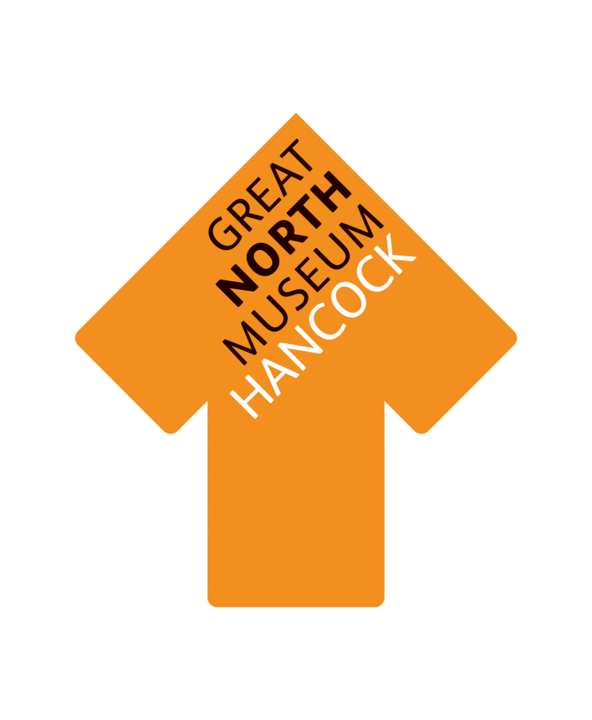GCSE Health and the People
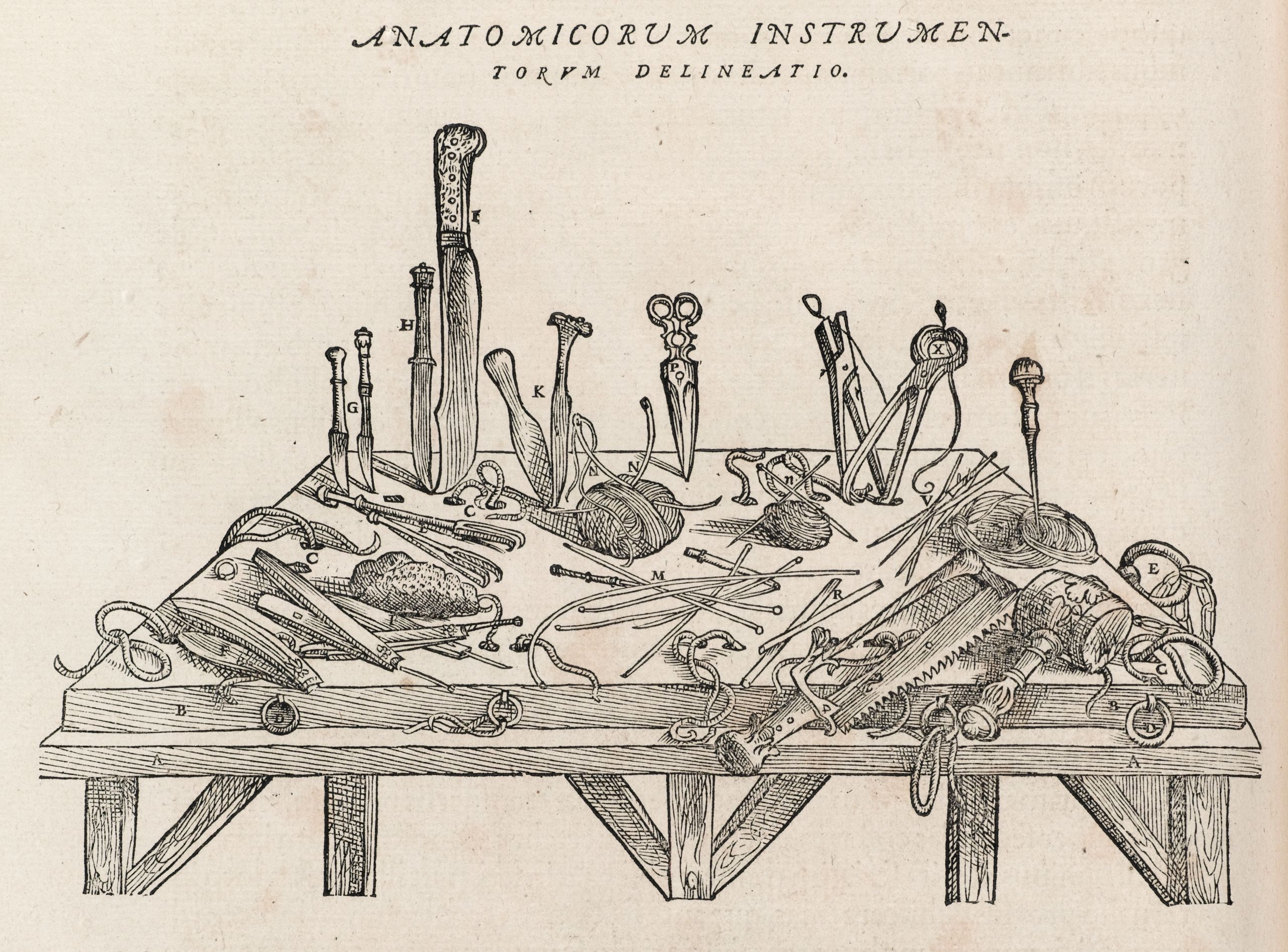
Your school is working in collaboration with the Great North Museum and Newcastle University Library to enable you to explore the History of Medicine through unique primary source material.
Over the coming weeks you will learn about some of the key people, events, and developments in medicine, from ancient times to the present day.
Along the way, you will encounter some fascinating books and objects and learn about current research taking place at Newcastle University in the fields of History and Medicine.
During this project you are going to be challenged to produce material for a public exhibition on the History of Medicine which will take place at the Great North Museum in the autumn. We hope that you’ll be able to visit the museum with your families and see your work on display alongside the rare books and artefacts and current academic research.
This online resource contains photographs and information about the unique primary sources in our collections, along with videos and activities.
The content has been designed to support your GCSE History studies, whilst at the same time encouraging you to think about potential future educational and career opportunities.
Your teachers will use some of the material in your History lessons but may also ask you to use the resource for home learning tasks.
As you’ll see from the tabs along the top, the resource has been divided into the following sections in order to make it easier to navigate:
- Ancient and Medieval Medicine
- Renaissance & Early Modern Medicine
- 19th Century Medicine
- Modern Medicine
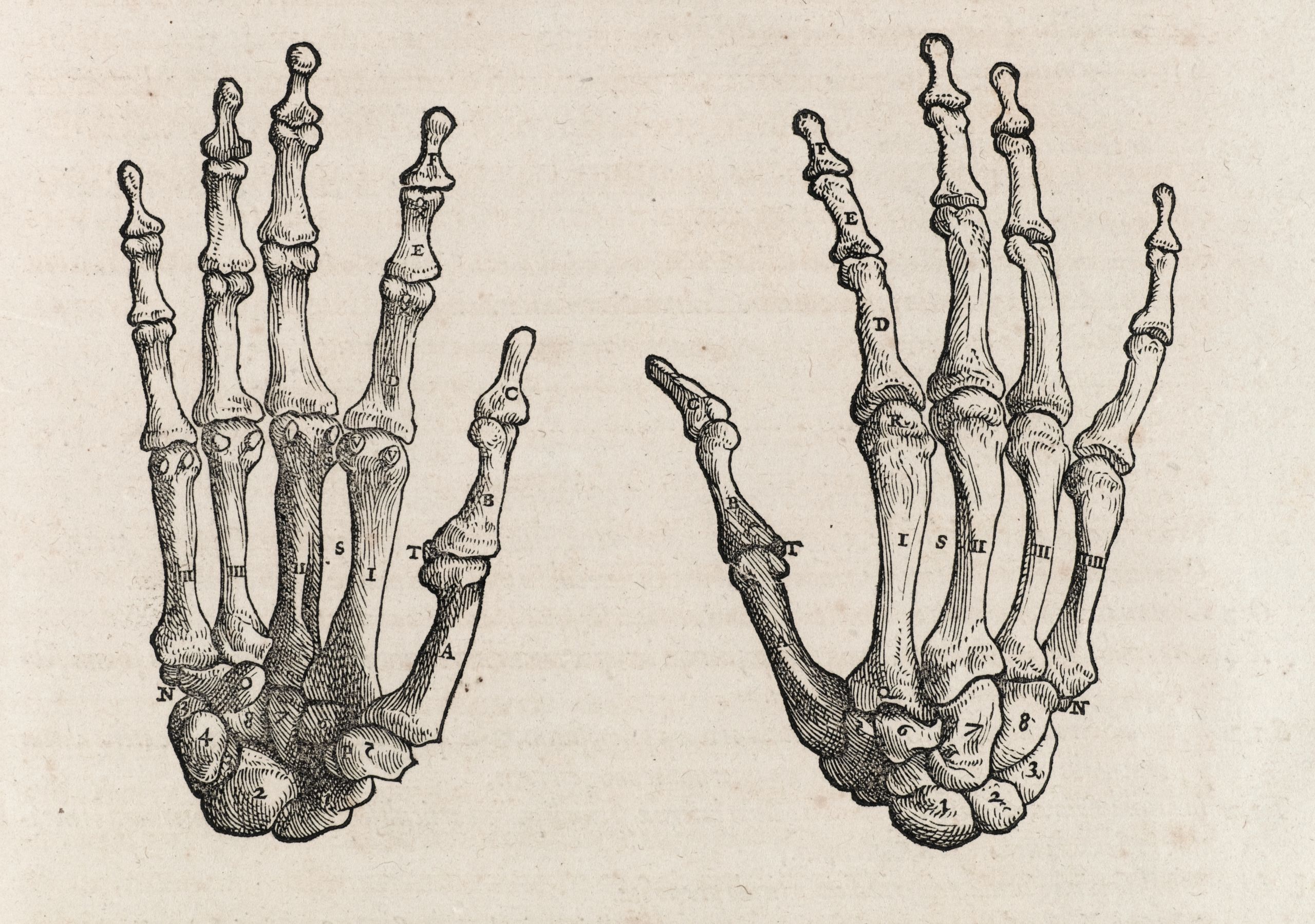
Ancient and Medieval
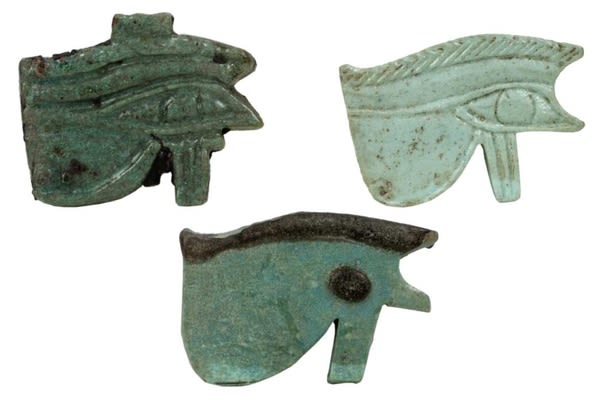
Ancient Medicine

Doctor Paul Hubbard talks about the origins of anatomy and surgery in ancient times.
Doctor Stephanie Holton, Lecturer in Classics at Newcastle University, gives a brief introduction to some core ideas in ancient medicine using objects from the Great North Museum’s collections.
Ancient Egypt (330-525 B.C.E):
The ancient Egyptians thought that diseases had supernatural causes. They believed that gods, demons and spirits caused disease and so they believed that prayer could help cure them. However, they also used natural remedies such as herbs.
Below are some Ancient Egyptian Amulets from the Great North Museum’s collections:
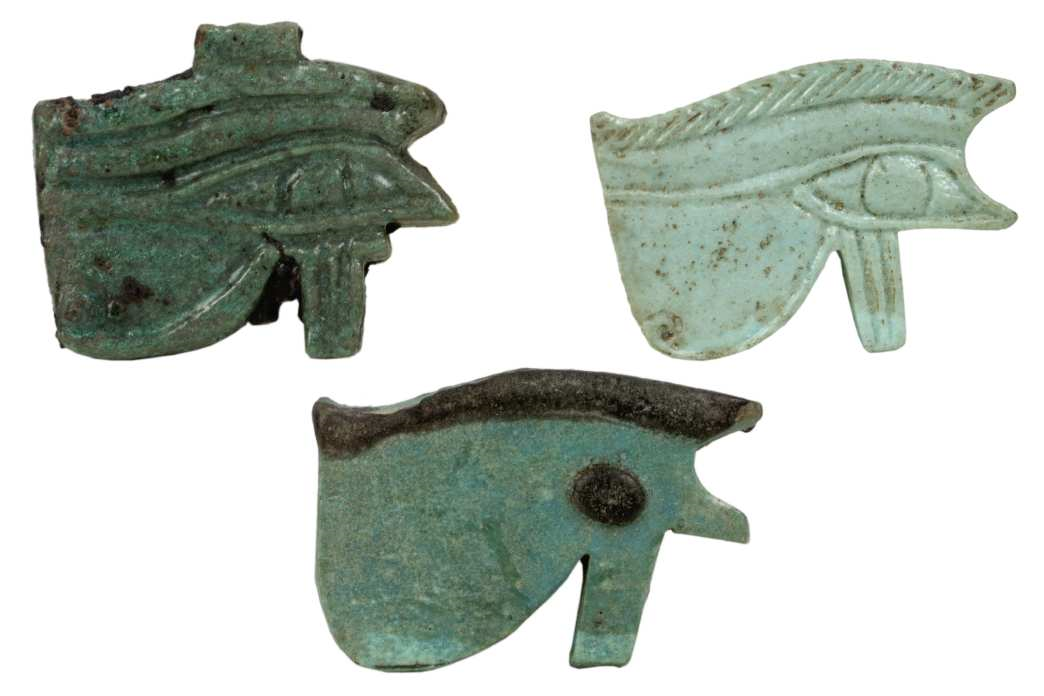
These turquoise glazed amulets were worn by the living dead in Ancient Egypt to protect against evil.
Ancient Greek medicine (c700 B.C.E- c600 C.E):
The Ancient Greeks used ideas from Egypt and developed new ideas, gradually moving away from a reliance on spiritual healing and began using more practical, natural solutions.
Below is an Ancient Greek feeding cup from the Great North Museum’s collections:
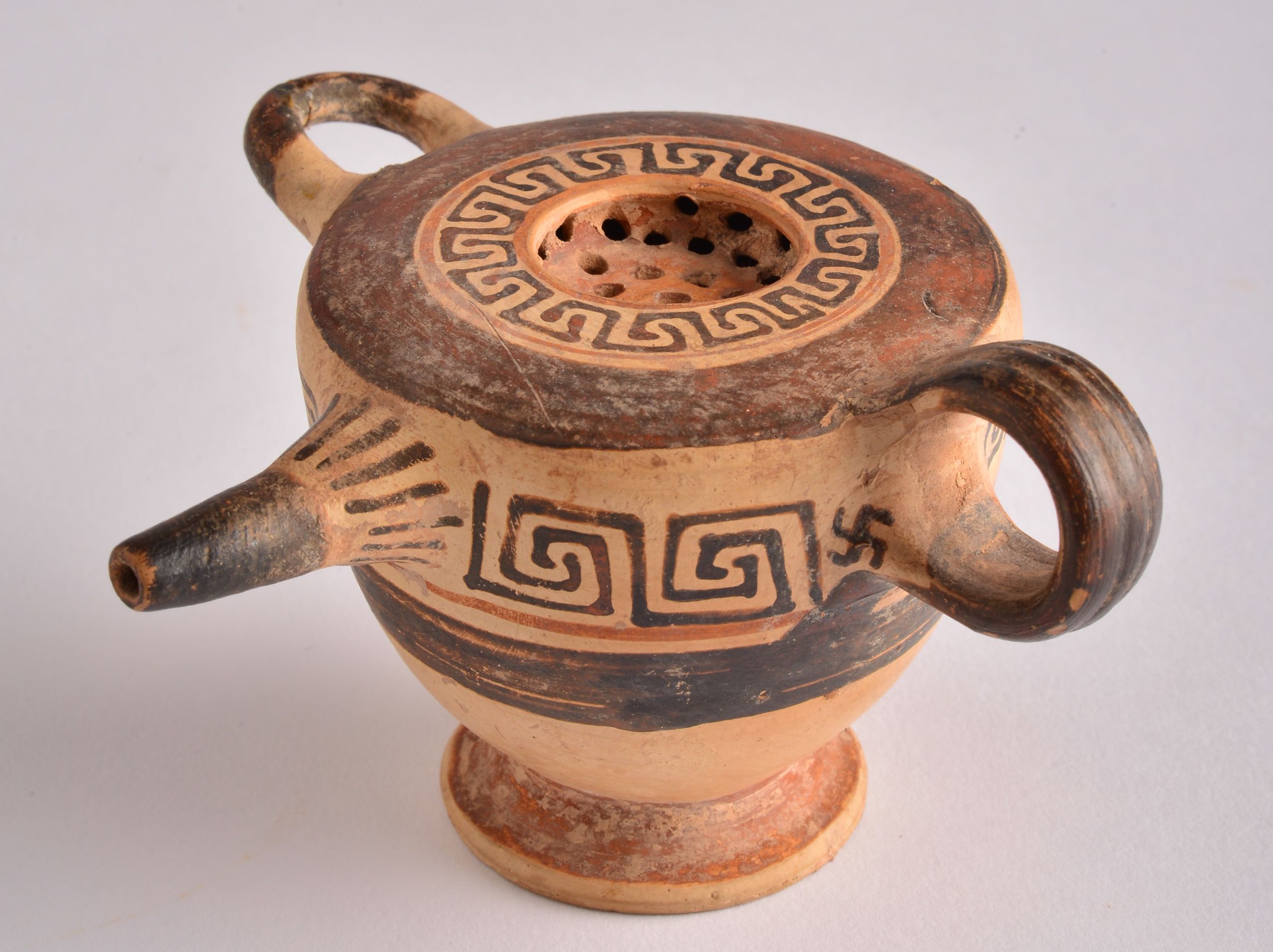
Feeding cups were most likely used for childcare purposes, as an alternative or addition to breastfeeding a baby or toddle.
Below is an image of Hippocrates
Aphorisms of Hippocrates : and the sentences of Celsus : with explanations and references to the most considerable writers in physick and philosophy, both ancient and modern, Pybus F.iv. 9, Pybus (Professor Frederick) Collection, Newcastle University Special Collections, GB 186
Aphorisms of Hippocrates : and the sentences of Celsus : with explanations and references to the most considerable writers in physick and philosophy, both ancient and modern, Pybus F.iv. 9, Pybus (Professor Frederick) Collection, Newcastle University Special Collections, GB 186
Hippocrates of Kos was the most famous Greek doctor. He wrote: “Sickness is not sent by the gods or taken away by them. It has a natural basis. If we an find the cause, we can find the cure”.
Hippocrates is often called the ‘Father’ of Modern Medicine.’ He made several key contributions to the development of medicine including:
- The Hippocratic Oath – Doctors would swear to treat patients and keep their records and symptoms in confidence. Upon qualifying, doctors still swear the Hippocratic oath today.
- The idea of the Four Humours – Hippocrates encouraged doctors to look for natural causes and cures of diseases, encouraging them to move away from supernatural beliefs. Hippocrates believed that the body was made of four fluids – blood, phlegm, yellow bile and black bile. They needed to be in balance for good health.
Below is a page from the Aphorisms of Hippocrates, a long series of propositions concerning the symptoms and diagnosis of disease and the art of healing and medicine. This book can be found in Newcastle University’s Special Collections.
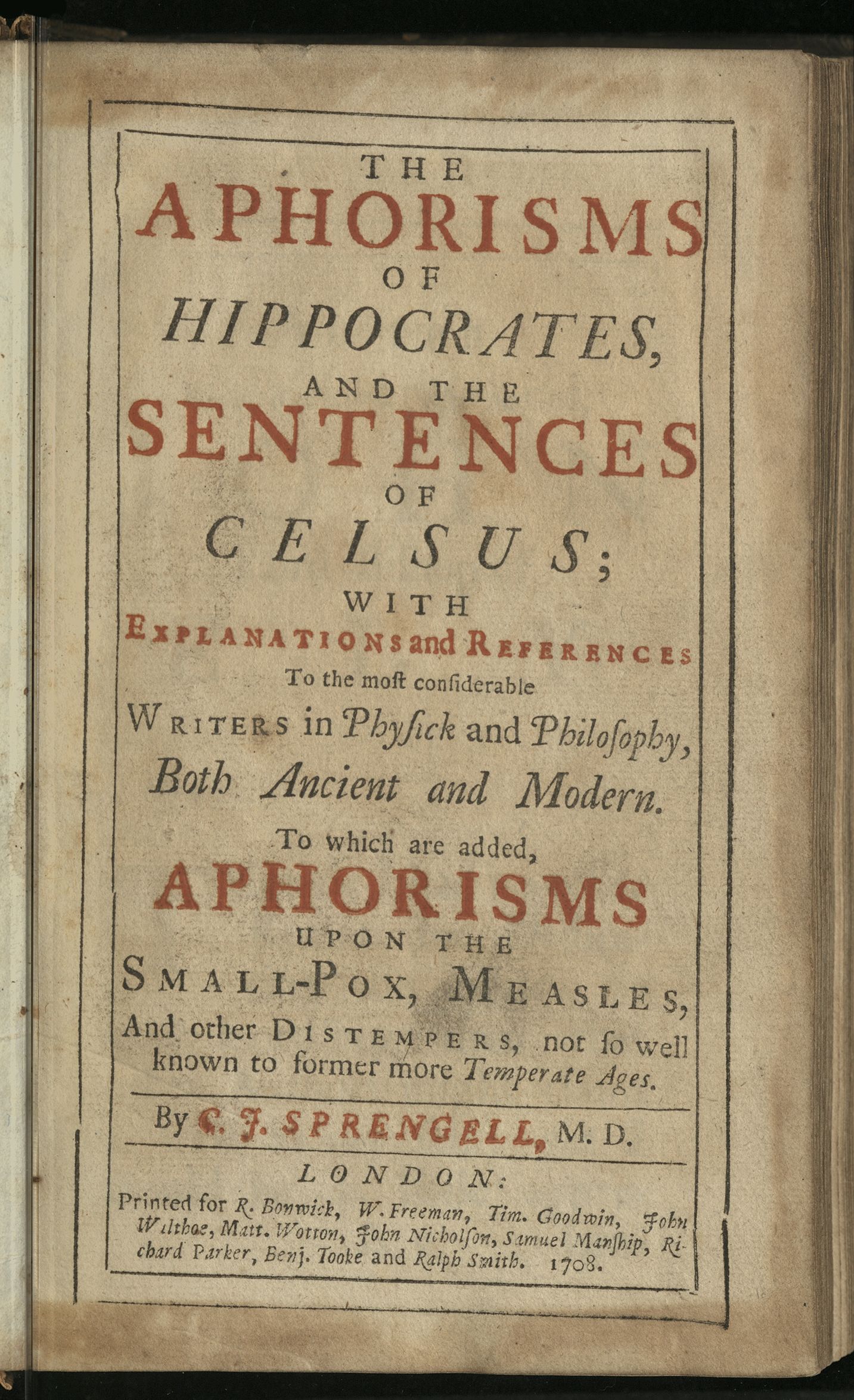
The works of Hippocrates were so influential that some of them, most notably the Aphorisms, were used as textbooks until the 19th century. This may explain why they can be found in the personal library of Professor Frederick Charles Pybus (1883-1975), an esteemed Newcastle medic and surgeon (and the inventor of Lucozade!), which is held in Newcastle University Library’s Special Collections.
ROMAN MEDICINE (c800BCE-c500CE):
Like the Ancient Greeks, the Romans also believed in spiritual healing. The cult of Aesculapius, for example, was a religious healing system which took its name from a Greek god of healing.
This is a Jet Finger Ring from the Great North Museum's Collections
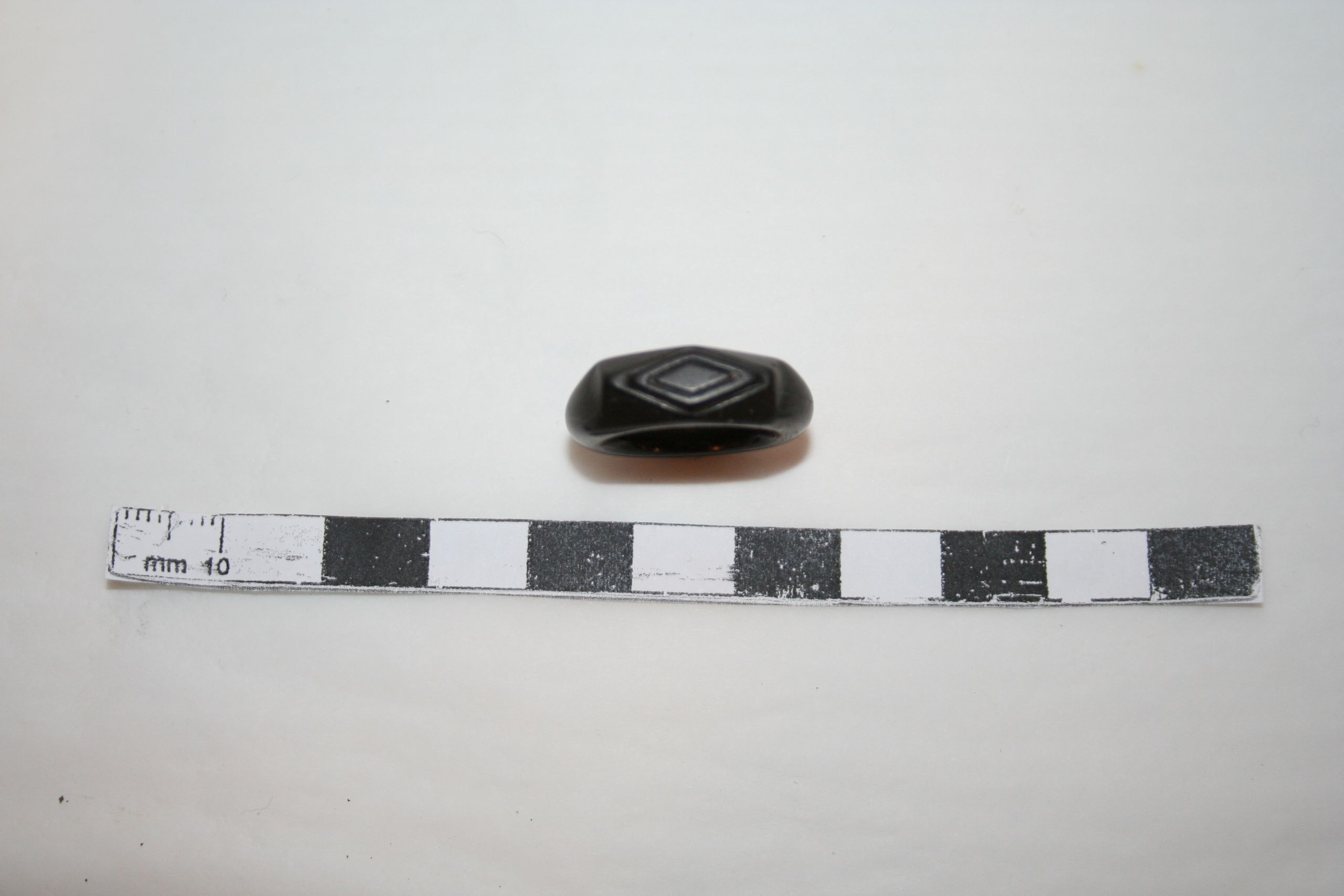
This Roman jet ring, dates from 100-399AD. It was found at Arbeia Roman Fort in South Shields. Jet was often used as a cure for ailments or sometimes worn to ward off/divert evil.
Roman medicine was heavily influenced by Ancient Greek medicine. For example, Hippocrates’ idea of the Four Humours was developed by Galen, another Greek doctor who spent most of his career in the Roman Empire.
Galen believed diseases could be treated by using opposites. He thought that different foods, drinks, herbs and spices had a humour, which could balance the excessive humour that was balancing the disease. Galen also believed in the miasma theory (i.e. that bad air caused disease when someone breathed it in. He is also famous for dissecting animals to understand how the body functioned, although as he didn’t dissect humans, some of his ideas was not correct.
Below is the frontispiece of the book "Of Black Bile" by Galen from Newcastle University Special Collections
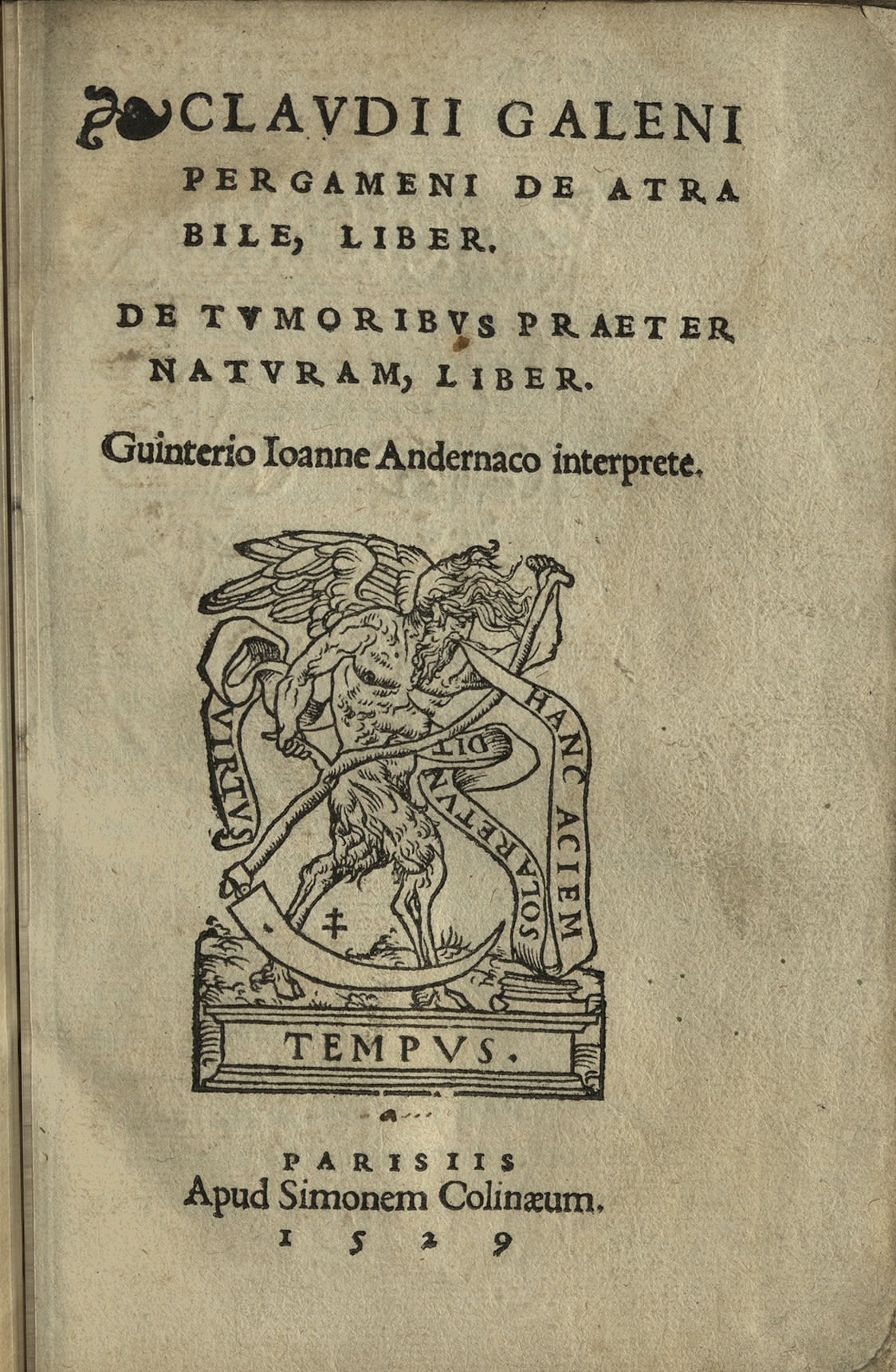
De atra bile, liber : De tumoribus praeter naturam, liber, Pybus A.iii.25, , Pybus F.iv. 9, Pybus (Professor Frederick) Collection, Newcastle University Special Collections, GB 186
De atra bile, liber : De tumoribus praeter naturam, liber, Pybus A.iii.25, , Pybus F.iv. 9, Pybus (Professor Frederick) Collection, Newcastle University Special Collections, GB 186
MEDIEVAL MEDICINE (c.1000 CE-c.1500 CE):
During the medieval period (c.1000 CE-c.1500 CE) medicine in the western world effectively stood still. Indeed, after the fall of the Roman Empire, during what historians refer to as the Dark Ages (c.450CE-c.1000CE), many of the ideas (including medical knowledge) of the Greeks and Romans was lost) and replaced by speculation and superstition. Fortunately, in the east, Arab doctors kept classical knowledge alive and gradually these ideas made their way back to western Europe.
Below is an image of a Medieval Hygiene Kit held in the Great North Museum:
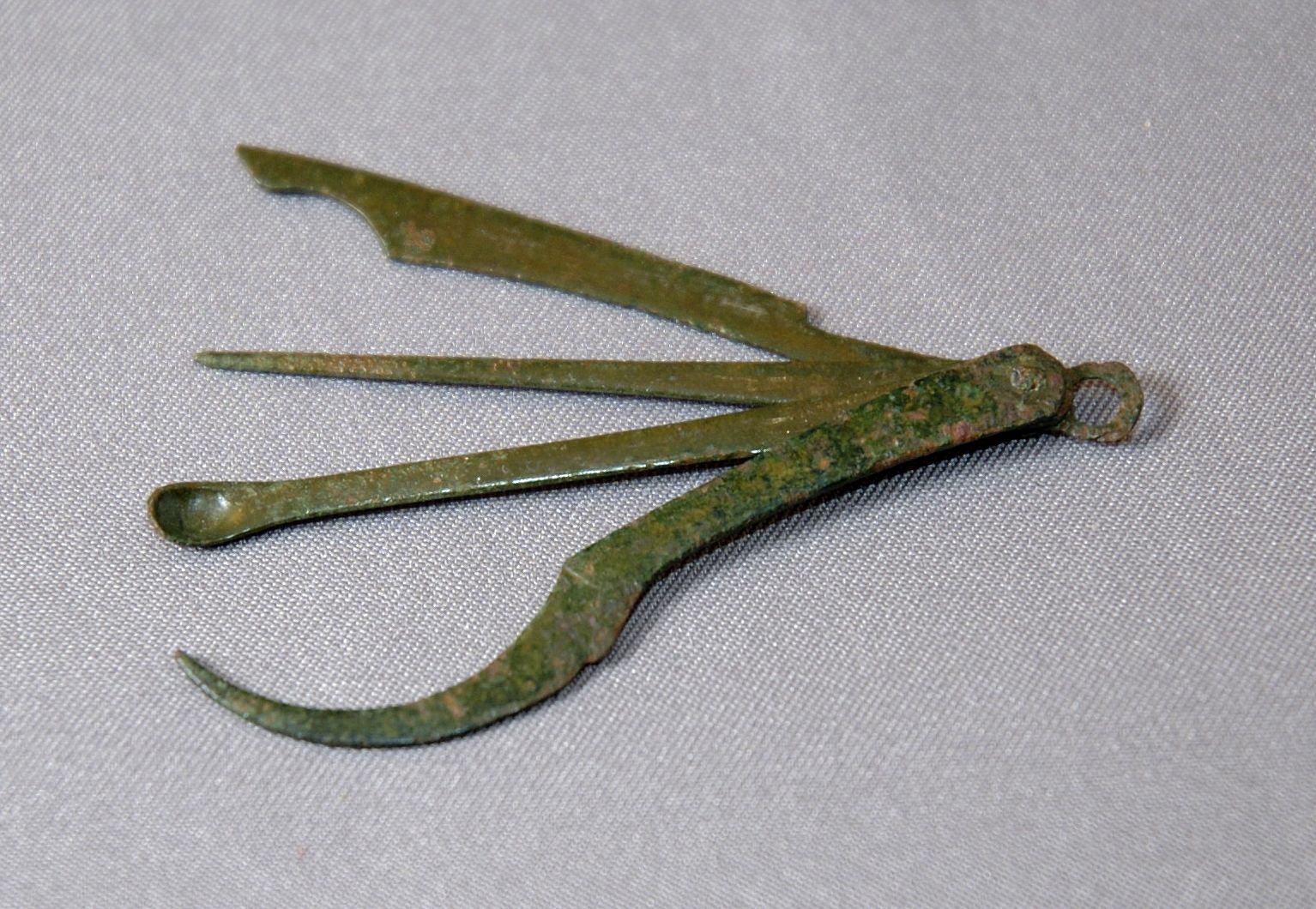
This hygiene kit was found at Chevington Chapel in Northumberland. It dates to the 13th/14th Century. The kit contains four tools: an ear scoop, nail cleaners, a straight toothpick and curved toothpick.
The image below is of a page from Opera chirurgica (Surgical works), by the 14th century British surgeon, John of Arderne, held in Newcastle University's Special Collections:
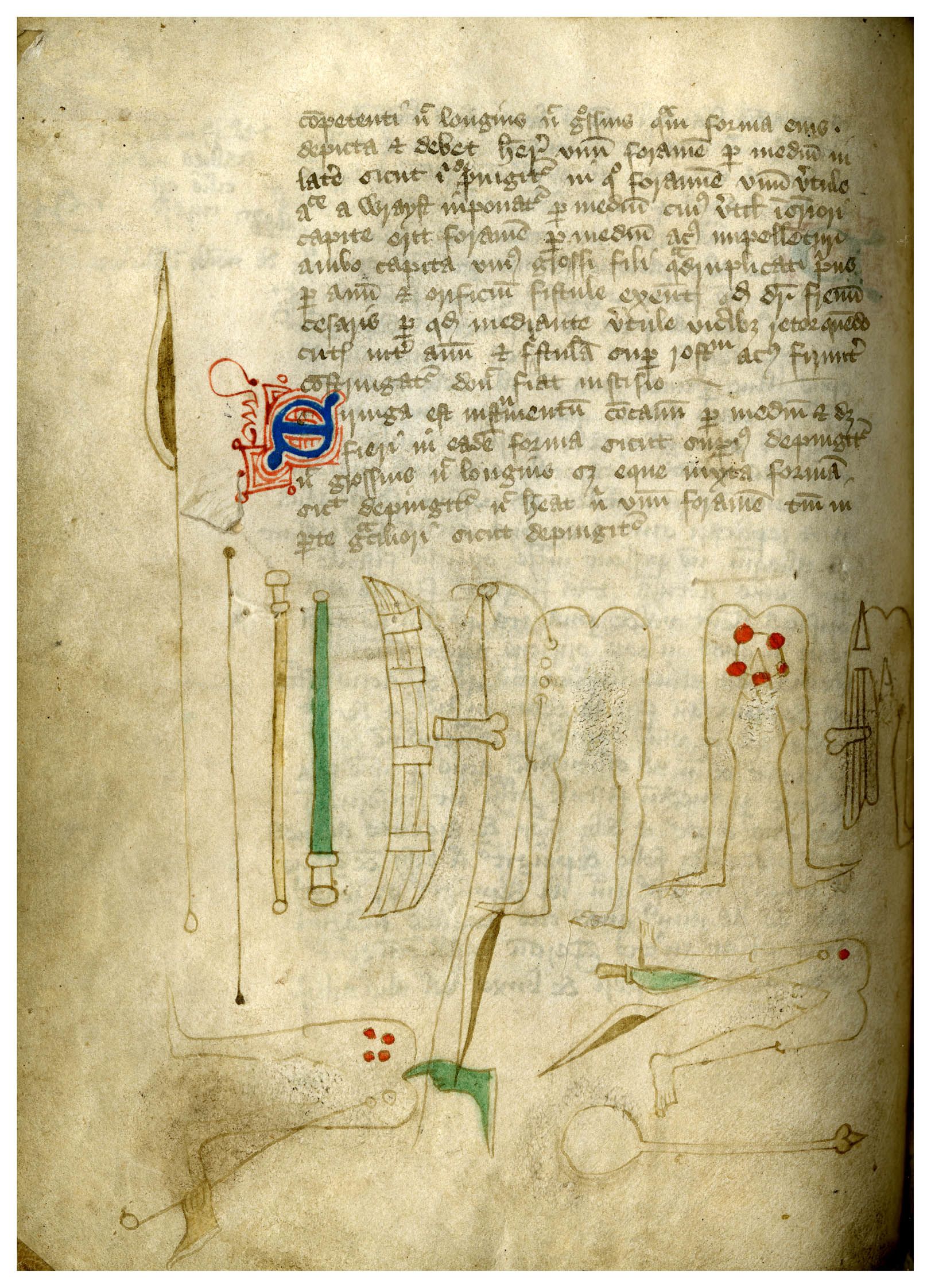
Page from Opera chirurgica showing marginalia illustrations (Pybus (Professor Frederick) Collection, Pybus, Pyb. C.v.5) Pybus Collection: Pyb C.v.5, Newcastle University Special Collections, GB 186.
Page from Opera chirurgica showing marginalia illustrations (Pybus (Professor Frederick) Collection, Pybus, Pyb. C.v.5) Pybus Collection: Pyb C.v.5, Newcastle University Special Collections, GB 186.
John of Arderne served as a military surgeon in France and also practiced in Newark and London. He wrote a number of medical texts and is often described as the father of English surgery. He is well known for using surgery to successfully remove for anal abscesses.
Arderne’s manuscripts were commonly illustrated. This manuscript, written in Latin but including some passages in French near the beginning, has been illustrated with pictures of operations, instruments and plants.
Renaissance and Early Modern
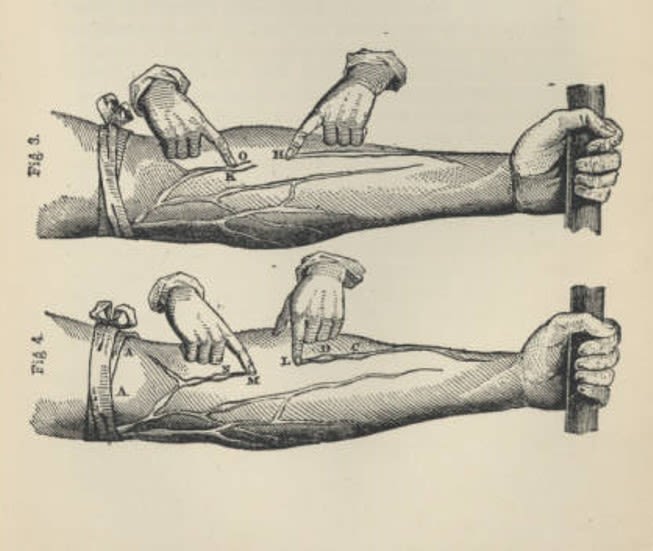
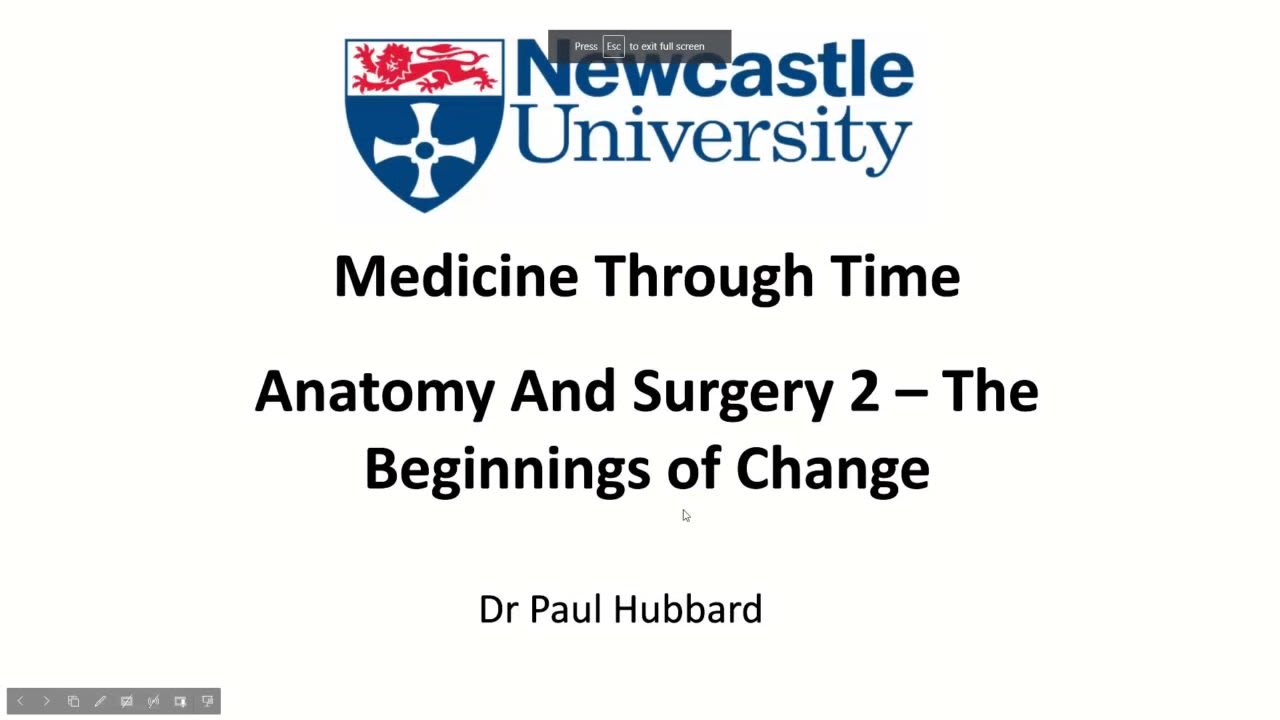
Lecture: Anatomy and Surgery- The Beginnings of Change (Renaissance) by Dr Paul Hubbard.
Lecture: Anatomy and Surgery- The Beginnings of Change (Renaissance) by Dr Paul Hubbard.
In the above video Doctor Paul Hubbard talks about some of the changes in anatomy and surgery during the Renaissance period.
During the Renaissance period knowledge from classical Greek and Roman times was rediscovered.
Western doctors gained access to the original writings of Hippocrates, Galen and Avicenna.
However, the Renaissance was a time of new ideas and fresh thinking. People began to challenge old beliefs and put forward new theories.
There was a move away from the magic and mysticism of medieval medicine. People thought about the human body themselves and came to their own conclusions about the causes of disease. They began to question Galen and other ancient doctors.
Andreas Vesalius
This is the frotnispiece of Andreas Vesalius’ famous book, the Fabric of the Human Body, held in Newcastle University Special Collections.
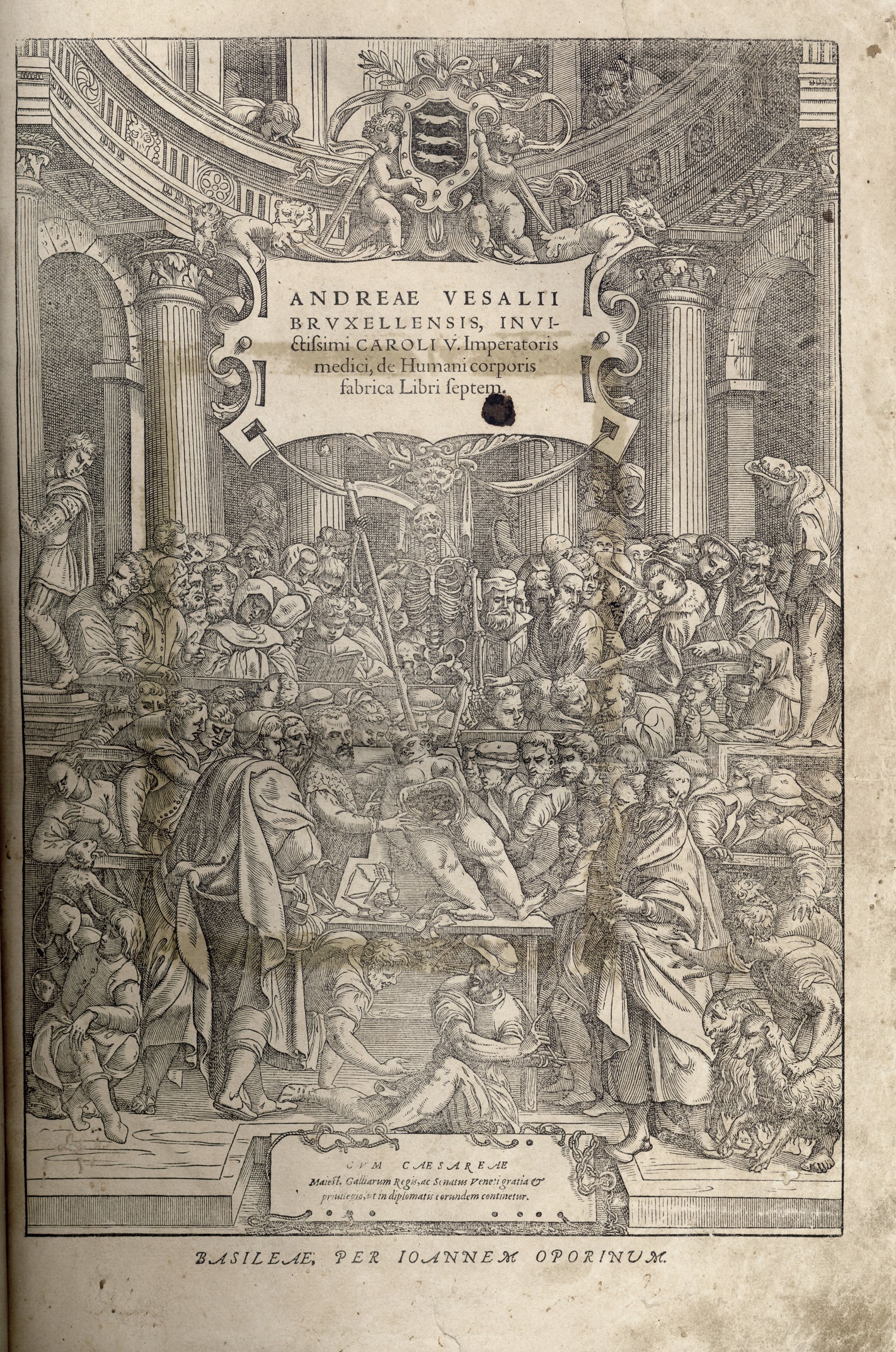
Andreas Vesalius was born in 1514 and was a medical professor at Padua University, Italy. He believed that successful surgery would only be possible if doctors had a proper understanding of anatomy.
Vesalius was able to perform dissections on criminals who had been executed. He wrote books based on his observations using accurate diagrams to illustrate his work. The most important was the ‘Fabric of the Human Body’ (1543).
Click Here to Have a Go at a Vesalius Source Based Activity
Ambrose Paré
These images of a prosthetic limb come from a book by the 16th century French army surgeon, Ambroise Paré, held in Newcastle University Special Collections
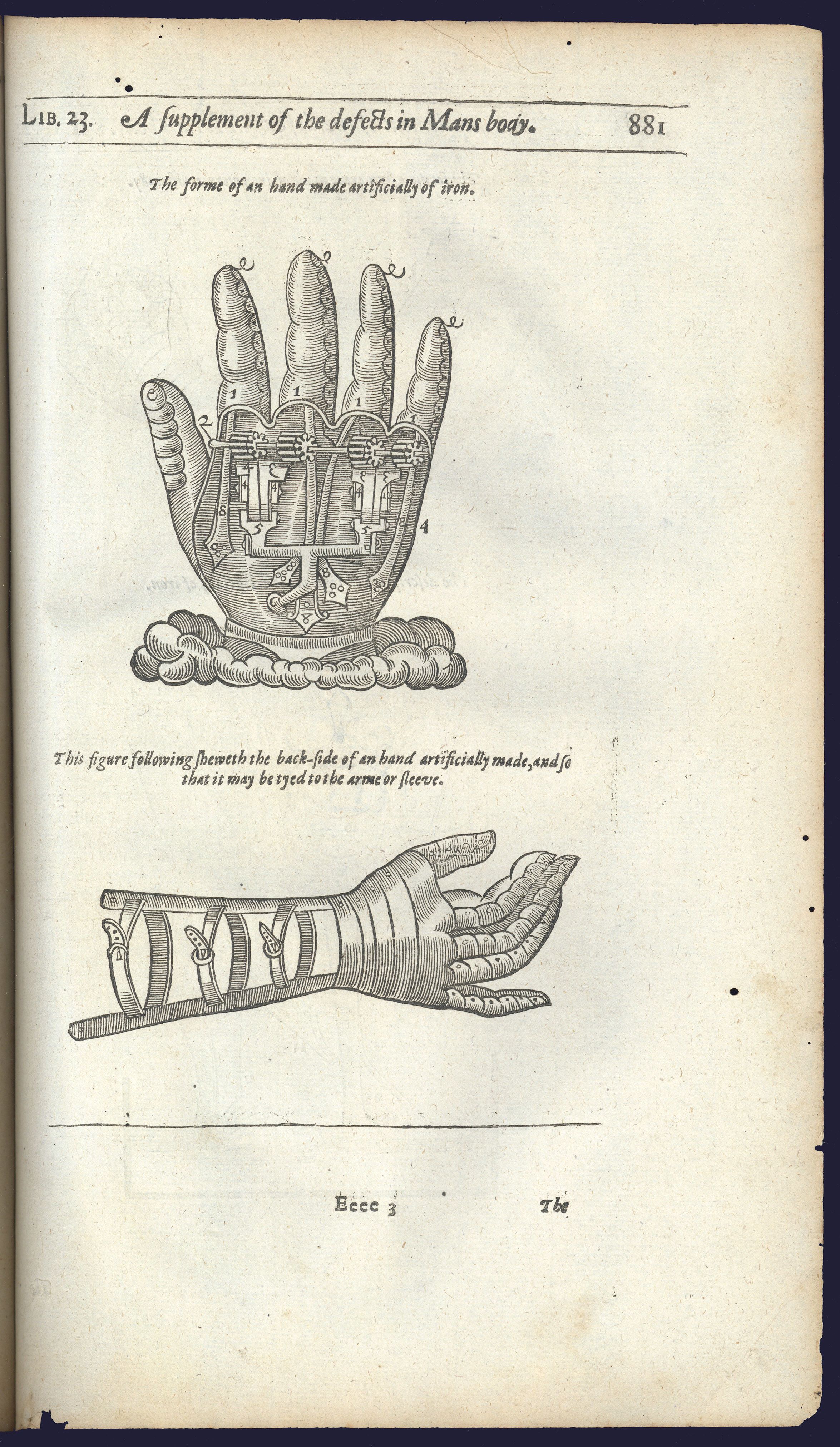
The works of that famous chiruigion [surgeon] Ambrose Parey. Pyb S.i.10, Pybus Collection, Newcastle University Special Collections, GB 186.
The works of that famous chiruigion [surgeon] Ambrose Parey. Pyb S.i.10, Pybus Collection, Newcastle University Special Collections, GB 186.
Paré treated many serious battlefield injuries which helped him improve surgical techniques. He improved the treatment of gunshot wounds by using a cool salve rather than boiling oil. He also invented a method of tying off vessels with threads (ligatures). He improved the treatment of amputations and designed artificial limbs.
Click Here to Have a Go at a Paré Source Based Activity
William Harvey
This illustration shows one of William Harvey’s experiments to show how blood is pumped around the body and that the valves in the veins will only allow the blood to flow in one direction.
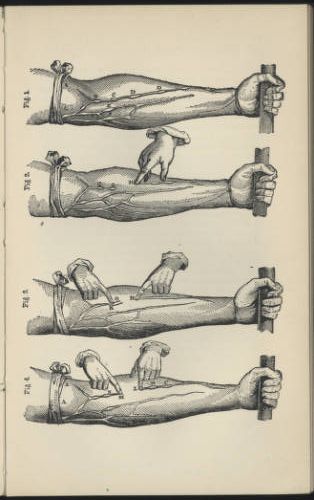
William Harvey was a British doctor who observed animal hearts in action and realised that his work would also apply to humans. Before Harvey, people thought that there were two kinds of blood and that they flowed through two separate systems of blood vessels (Galen’s idea). Harvey realised that Galen was wrong. He thought that the blood must circulate round the body. He published his book ‘On the motions of the heart and blood’ in 1628.
Click Here to Have a Go at a Harvey Source Based Activity
This is a page from Nicholas Culpeper’s English Physician and complete herbal, which was first published in 1653 (although this edition much later). It describes a herbal remedy for whooping cough.
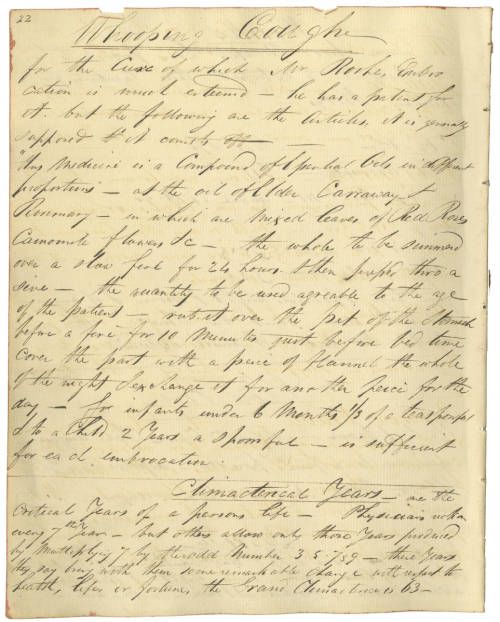
RB633.88 CUL, Culpeper's English Physician; and complete herbal, 1802, Rare Books, Newcastle University Special Collections, GB186
RB633.88 CUL, Culpeper's English Physician; and complete herbal, 1802, Rare Books, Newcastle University Special Collections, GB186
Herbal remedies bought from an apothecary, local wise woman or made at home had been popular in medieval Britain. However, the introduction of the printing press in the late 1400s meant that in the Renaissance period it was easier for people to access books on herbal remedies.
The Great Plague
In 1665 there was an outbreak of Bubonic plague in England. Just like in the medieval period, many treatments of the plague were based on magic, religion and superstition including wearing lucky charms or amulets, saying prayers or fasting.
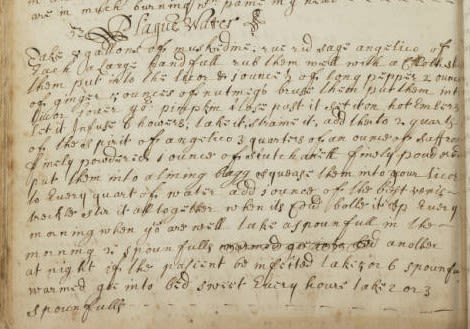
Plague Water recipe, page 104, Jane Loraine's Recipe Book (c.1684), Miscellaneous Manuscripts, Misc. MSS. 5, Newcastle University Special Collections, GB 186
Plague Water recipe, page 104, Jane Loraine's Recipe Book (c.1684), Miscellaneous Manuscripts, Misc. MSS. 5, Newcastle University Special Collections, GB 186
This is a recipe taken from a handwritten recipe book created in Northumberland in the 17th century. It is a recipe for Plague Water, a medicinal drink with would allegedly protect the drinker from the Plague.
Edward Jenner and Vaccination
Below is a drawing of infection of milkmaid Sarah Nelmes as part of Edward Jenner’s experiment into vaccination for smallpox. Jenner invented a vaccination against smallpox by using pus from a cowpox sore.
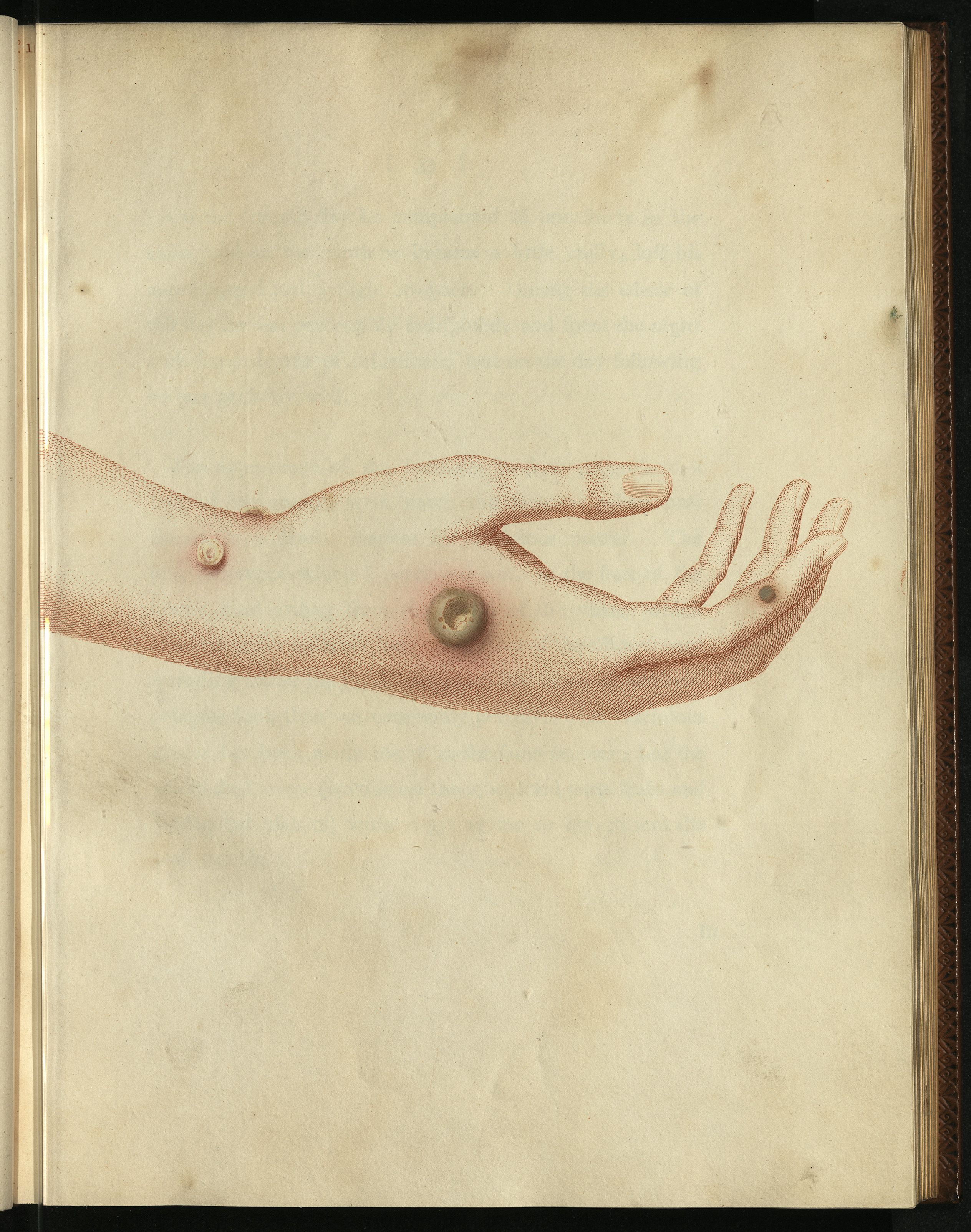
An inquiry into the causes and effects of the variolæ vaccinæ : a disease discovered in some of the western counties of England, particularly Gloucestershire, and known by the name of the cow pox, 1798, E.i.06, Pybus (Professor Frederick) Collection, Newcastle University Special Collections, GB 186.
An inquiry into the causes and effects of the variolæ vaccinæ : a disease discovered in some of the western counties of England, particularly Gloucestershire, and known by the name of the cow pox, 1798, E.i.06, Pybus (Professor Frederick) Collection, Newcastle University Special Collections, GB 186.
In the below extract from Jenner’s book, "An Inquiry into the Causes and Effects of the Variolae Vaccinae", 1798, Jenner describes how James Phipps, an 8 year old boy was given cow pox from the pus of the milkmaid Sarah Nelmes, and was then given the more deadly smallpox virus and never developed the disease proving that vaccination worked.
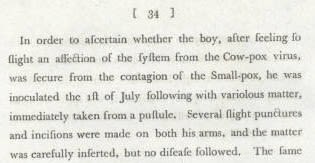
An inquiry into the causes and effects of the variolæ vaccinæ : a disease discovered in some of the western counties of England, particularly Gloucestershire, and known by the name of the cow pox, 1798, E.i.06, Pybus (Professor Frederick) Collection, Newcastle University Special Collections, GB 186.
An inquiry into the causes and effects of the variolæ vaccinæ : a disease discovered in some of the western counties of England, particularly Gloucestershire, and known by the name of the cow pox, 1798, E.i.06, Pybus (Professor Frederick) Collection, Newcastle University Special Collections, GB 186.
Click Here to Have a Go at Jenner Source Based Activities
Joseph Lister and Antiseptics
This is a photograph of Joseph Lister’s Carbolic Spray from Newcastle University Special Collections and Archives.
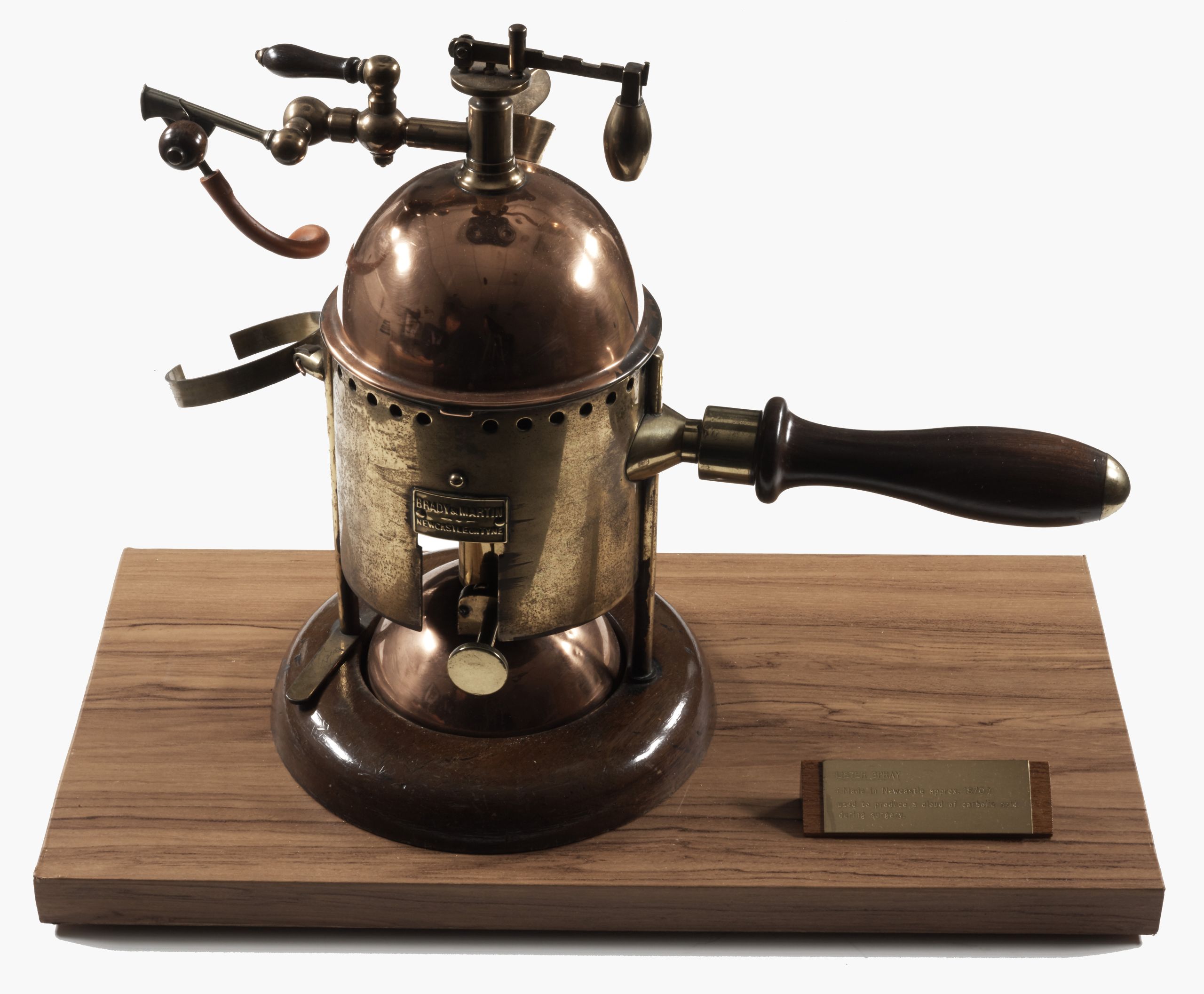
Joseph Lister was a British surgeon who made a significant contribution to the development of antiseptic surgery. He heard about Germ Theory in 1865 and realised that germs could be in the air, on instruments and people’s hands so he started using carbolic spray, an antiseptic in his operating theatre and on medical instruments and bandages.
19th Century
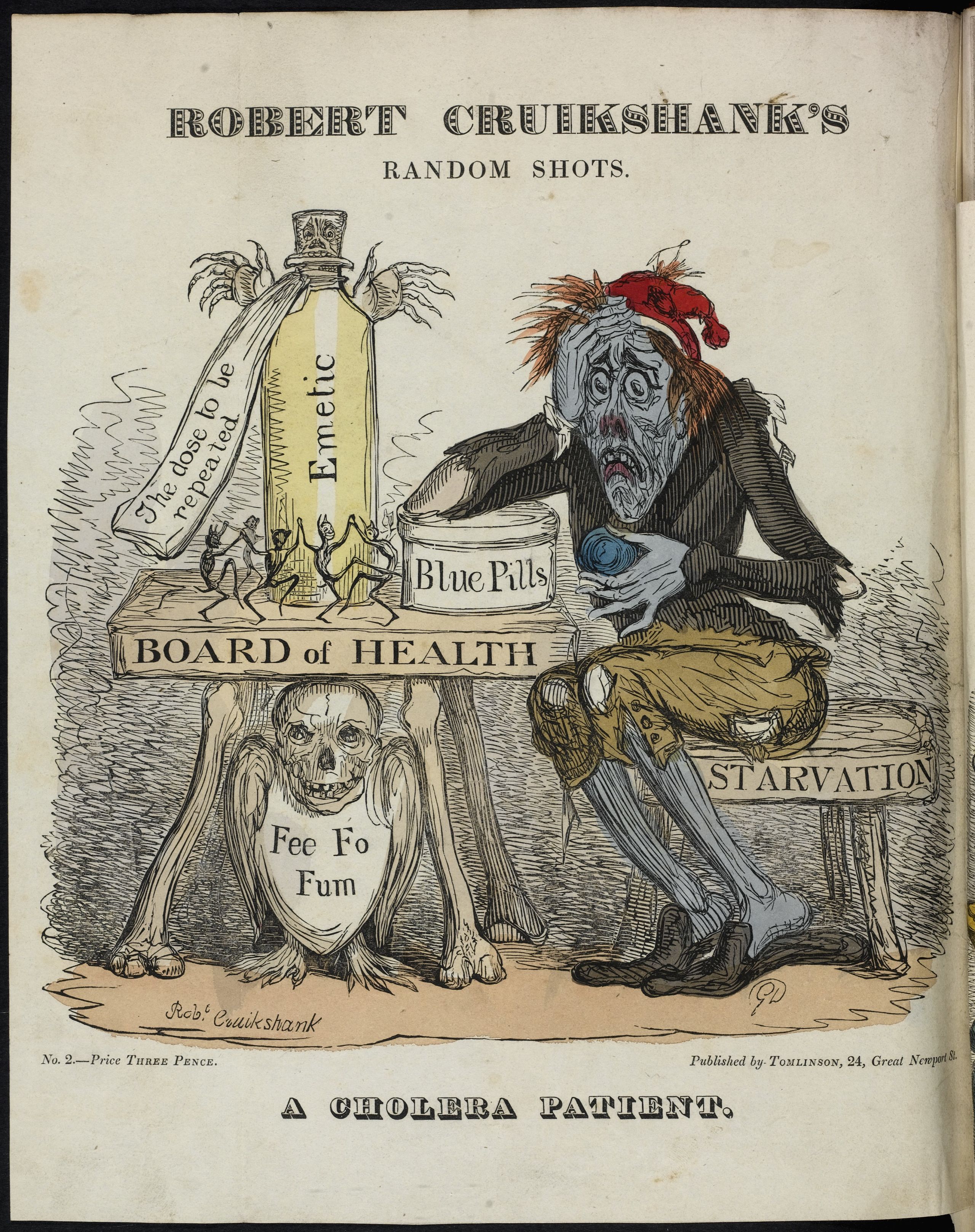

Lecture: Anatomy and Surgery- Revolution in Medicine by Dr Paul Hubbard.
Lecture: Anatomy and Surgery- Revolution in Medicine by Dr Paul Hubbard.
In the above video Doctor Paul Hubbard talks about developments in anatomy and surgery from the 19th Century to the present day.
Cholera in Gateshead
Cholera reached Britain in 1831 and by 1832 it was an epidemic – over 21,000 people in Britain died of cholera that year. At the time people didn’t know about germs. They didn’t know that cholera was caused by bacteria in drinking water – the best theory was miasma (bad air).
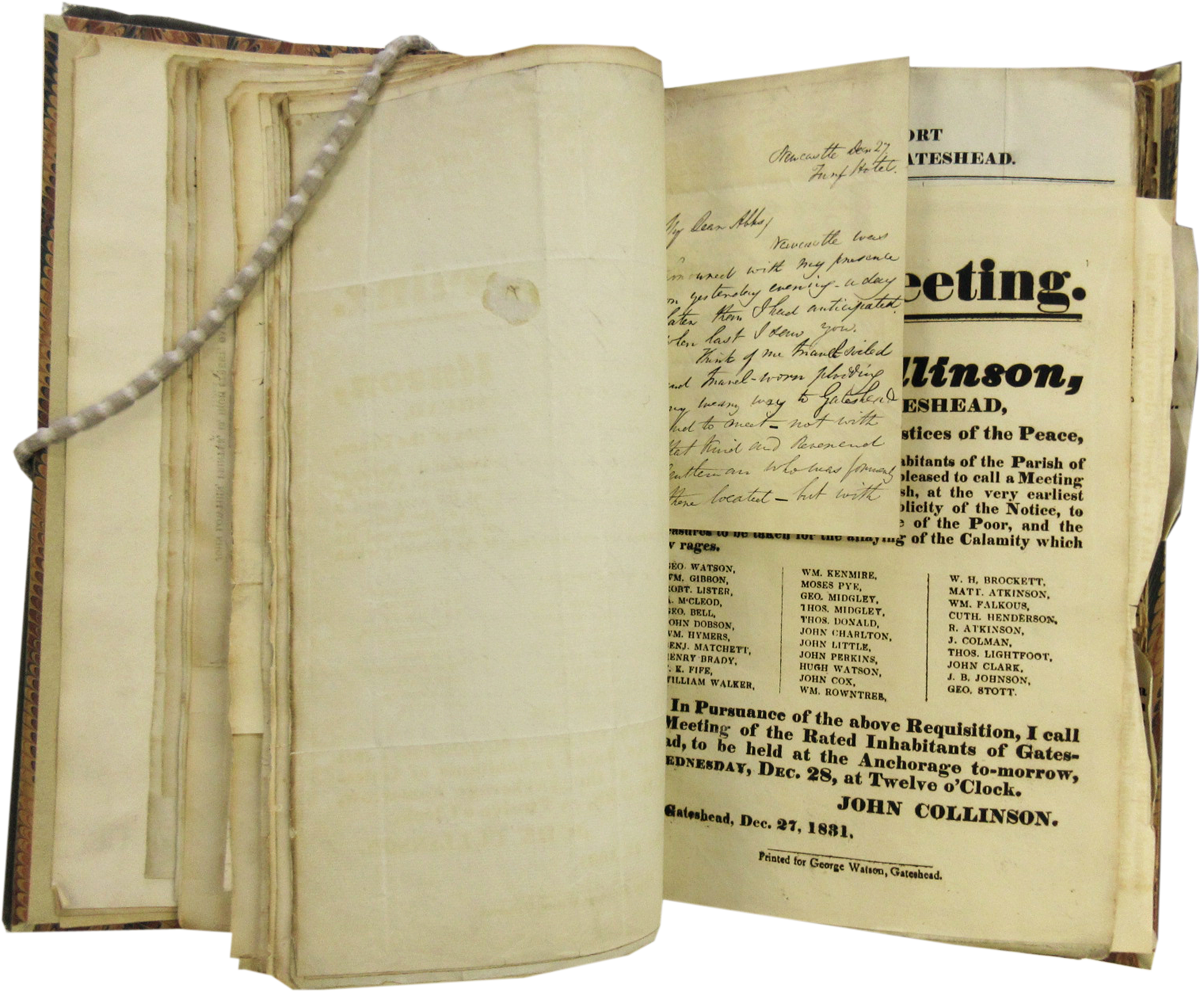
This is a scrap book containing cuttings about the outbreak of cholera in Gateshead in 1831-2. It is a fantastic resource for learning about our local history.
It includes a letter from a daughter to her father telling him that cholera has broken out in Gateshead, an account of the first death, reports of the daily number of dead, notices from the Board of Health advising people on the actions they should take to try to prevent cholera and an advertisement for tincture to ‘cure’ cholera.
Modern
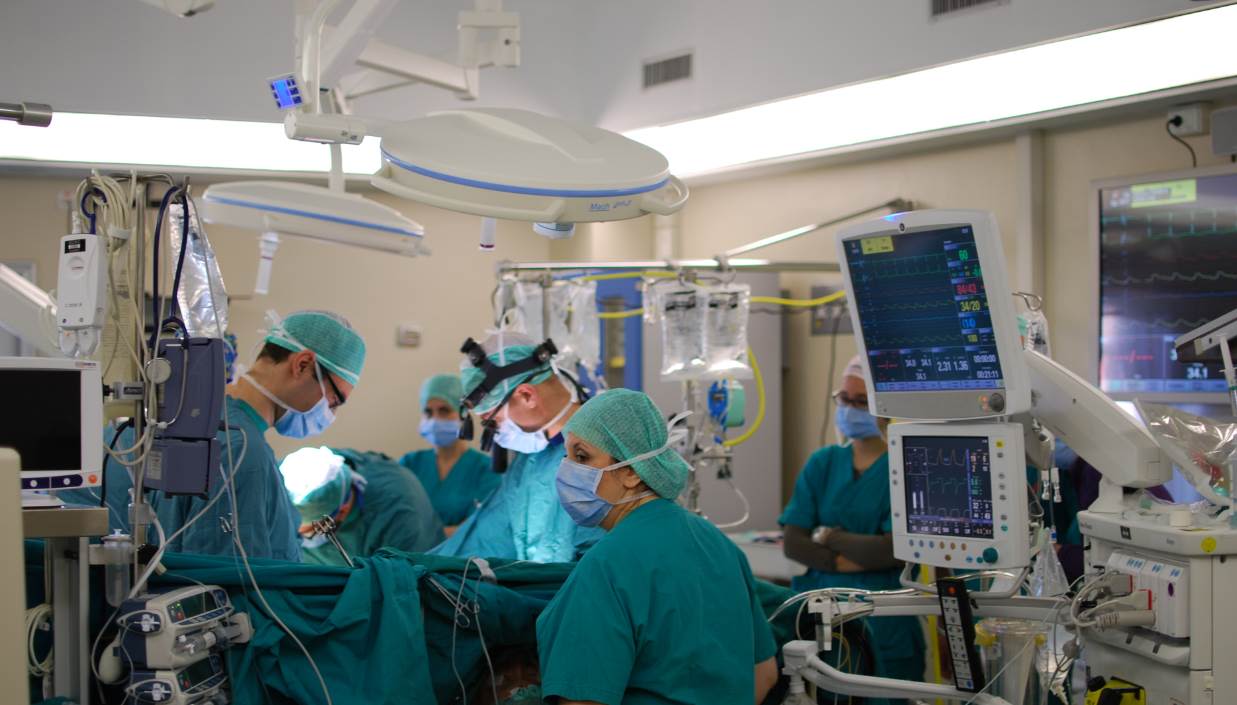
Medicine has developed rapidly throughout the 20th and 21st centuries.
Some notable developments include the discovery of antibiotics, the creation of the National Health Service, MRI scans and X- rays, blood transfusions and transplants, radiation therapy and keyhole surgery.
You can find out about some of the exciting medical research which is currently taking place at Newcastle University by watching the short videos below. This includes research into Parkinson's disease, the identification of Stroke patients and Cancer treatments.
Newcastle University PhD student Cameron Kirk talks about his research into what walking can tell us about Parkinson’s disease.
Newcastle University PhD student Gemma Bate talks about her research involving the use of wearable censors to monitor movement and sleep in people with Parkinson’s disease.
Dr Philip Manning, a lecturer in the Medical School at Newcastle University, explains some of the cancer research that’s going on at Newcastle University to improve identification of cancerous cells and improve surgical precision.
Research Assistant Hannah Lumley from Newcastle University Stroke Research group talks about a potable test to identify a new portable test to identify stroke patients.

